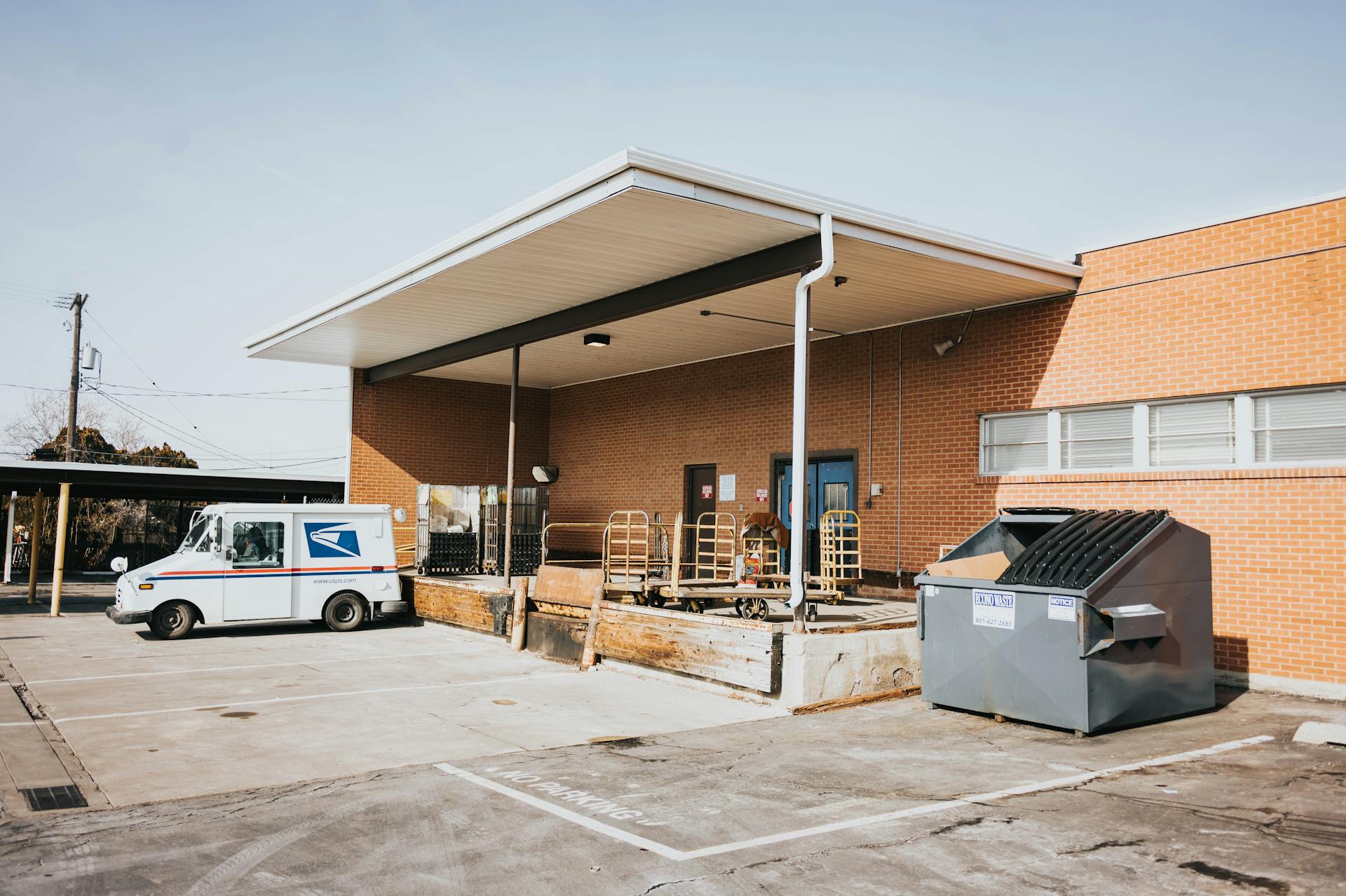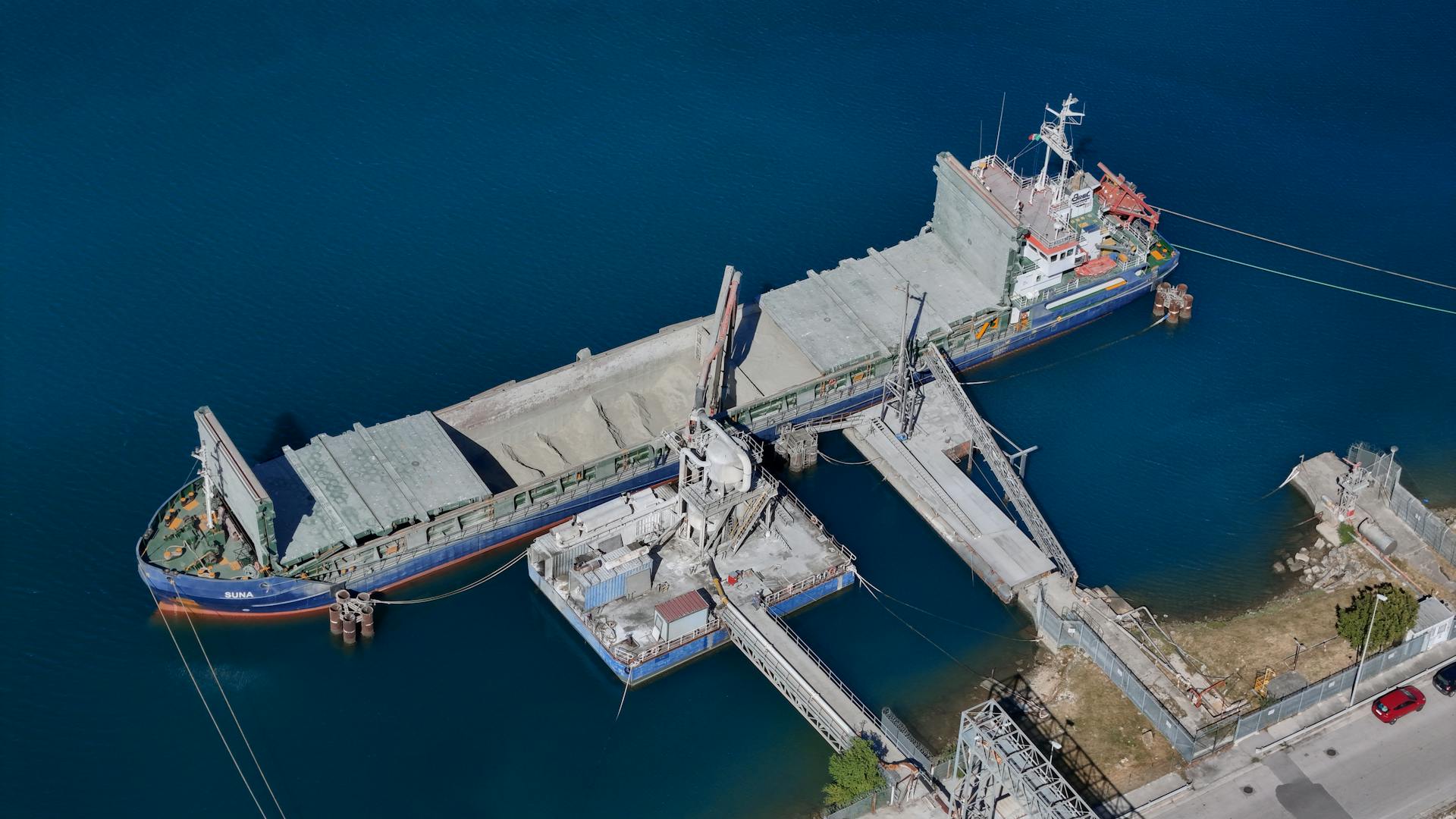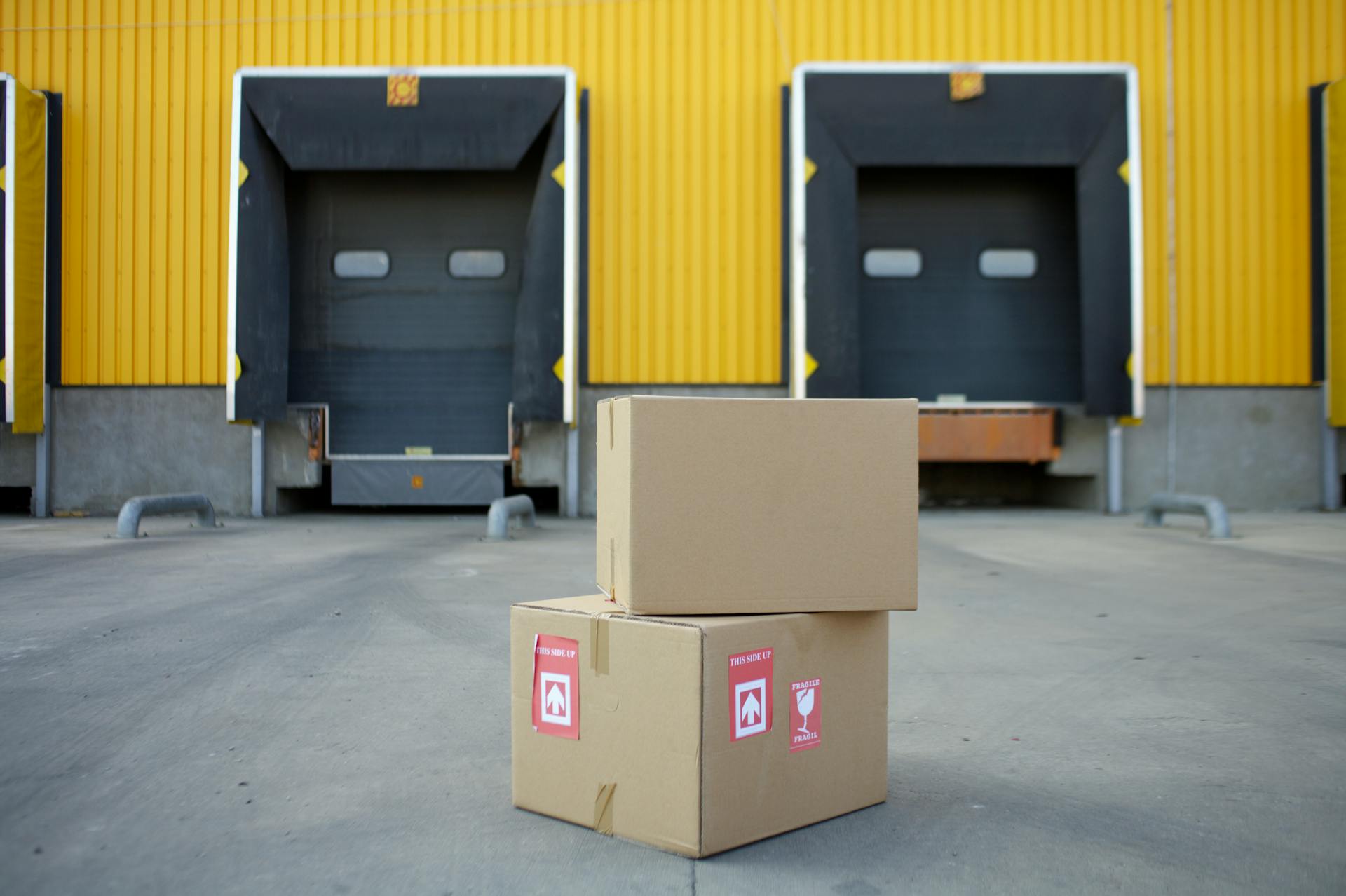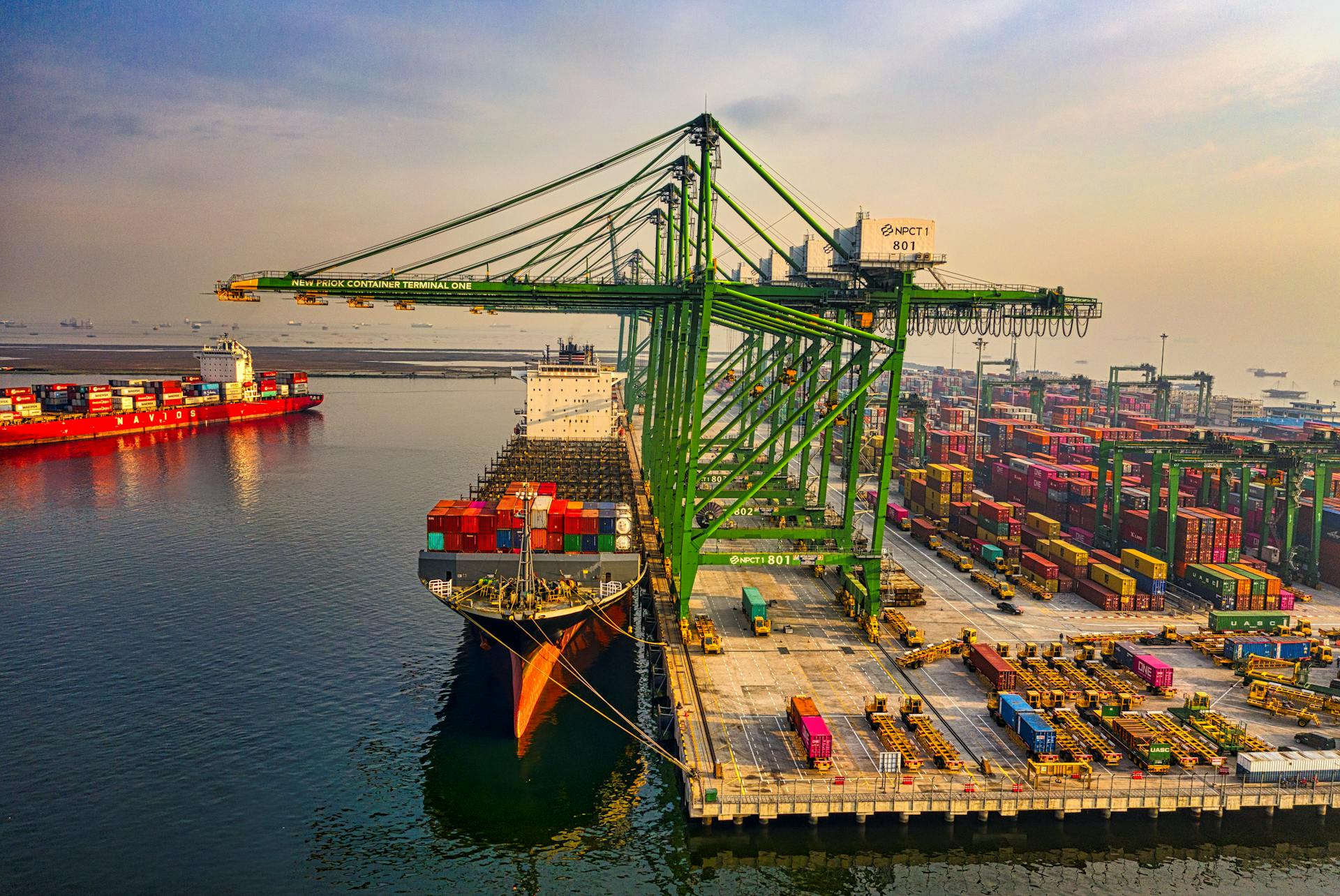
A loading dock canopy is a must-have for any business that receives regular deliveries. It protects goods and equipment from the elements, which can cause damage and deterioration.
The canopy shields goods from direct sunlight, which can cause fading, warping, and discoloration. This is especially important for sensitive items like electronics and pharmaceuticals.
A loading dock canopy can also protect equipment from rain and snow, which can cause rust and corrosion. This is crucial for heavy machinery and equipment that's used in the warehouse.
By installing a loading dock canopy, businesses can reduce the risk of damage and extend the lifespan of their goods and equipment.
Worth a look: Loading Dock Safety Equipment
Types of Loading Docks
There are several types of loading docks, each designed to meet specific needs and environments.
The most common type is the fixed loading dock, which is permanently attached to the building and can be found in warehouses and distribution centers.
A pit loading dock is another type, which is recessed into the ground, allowing trucks to drive directly into the loading area.

A dock leveler can be installed with a fixed or pit loading dock to facilitate easy loading and unloading of goods.
A portable loading dock is a freestanding dock that can be moved to different locations as needed, often used in temporary or seasonal applications.
A drive-in loading dock is designed for warehouses with high ceilings, allowing trucks to drive directly into the loading area without the need for a pit.
A ramp loading dock is similar to a drive-in dock but has a gentler slope, making it suitable for trucks with low ground clearance.
Benefits of Loading Dock Canopies
Loading dock canopies are a game-changer for any business that relies on efficient loading and unloading processes. They provide a clear and organized space for managing shipments, reducing the time and effort required to manage shipments.
A well-designed canopy can help streamline traffic flow around the loading dock, minimizing congestion and enhancing overall productivity. This is especially important during peak hours or when dealing with large shipments.

One of the primary benefits of loading dock canopies is protection from the elements. Weather conditions like rain, snow, and extreme heat can disrupt loading and unloading processes, leading to delays and potential damage to goods. By installing a canopy, you create a sheltered area that keeps your loading dock dry and shaded.
Loading dock canopies also contribute to improved efficiency by providing a tight seal against rainwater, preventing white light infiltration, and eliminating moisture build-up. This creates a safer working environment for workers in the loading dock area.
Some key features to look for in a loading dock canopy include:
- Tight seal against rainwater
- White light prevention
- Moisture elimination
- Galvanized head frame for rainwater diversion
- Durable materials like 40oz Hi-Tear vinyl or 40oz Hi-Performance Hypalon
By investing in a high-quality loading dock canopy, you can improve the efficiency and productivity of your loading dock operations, while also providing a safer and more comfortable working environment for your staff.
Common Issues and Solutions
A loading dock canopy can be a game-changer for businesses, but like any infrastructure, it's not immune to issues.

Water pooling under the canopy is a common problem that can lead to structural damage and even collapse.
To prevent water pooling, ensure the canopy's slope is at least 2% to 5% to allow water to drain properly, as mentioned in the article section on "Design Considerations."
Regular maintenance is key to extending the lifespan of a loading dock canopy.
Neglecting to clean the canopy regularly can lead to the buildup of dirt, dust, and debris, which can compromise its structural integrity.
In addition to regular cleaning, inspecting the canopy for signs of wear and tear, such as cracks or rust, can help identify potential issues before they become major problems.
Outrigger
The Outrigger Loading Dock Canopy is a great solution for those who need a lower profile. It offers a fascia height of either 12 or 14 inches, making it a more compact option.
This cantilever design allows for unobstructed access, which is a big advantage. You can move around freely under the canopy without any obstructions.

The Outrigger is compatible with standard dock configurations, making it easy to integrate into your existing setup. This means you don't have to worry about making significant changes to your dock.
You have a wide range of color options to choose from, with 25+ standard Kynar colors available. This ensures that the Outrigger can be seamlessly integrated into your building's architecture.
Enhanced Safety
Safety is a crucial concern in any loading dock operation. Canopies can significantly enhance safety by providing better visibility. Metal hoods or canopies can also protect overhead sectional steel doors from damage.
Slippery or wet surfaces can cause accidents, but canopies can reduce this risk. By maintaining a safer work environment, you protect your employees. Injuries related to harsh weather conditions can be prevented with a canopy.
Overhead sectional steel doors protected by metal hoods can be a great solution for enhanced safety. This setup can provide a safe and dry area for employees to work.
For another approach, see: Loading Dock Safety Lights
Lifespan Extension of Equipment

Loading dock equipment like forklifts and pallet jacks can be sensitive to weather conditions, which can lead to premature wear and tear.
Constant exposure to rain, snow, and UV rays can cause damage to these machines, resulting in higher maintenance costs and potential breakdowns.
Using a loading dock canopy can help protect equipment from the elements, thereby extending its lifespan.
Loading dock canopies can also reduce maintenance expenses by shielding equipment from harsh weather conditions.
If you're looking to extend the lifespan of your equipment, consider investing in a loading dock canopy.
Here are some benefits of using a loading dock canopy:
- Protects equipment from rain, snow, and UV rays
- Reduces maintenance expenses
- Extends the lifespan of equipment
Issue 3: Damaged Goods
Damaged goods are a common issue in warehouses and facilities. Water dripping off the top of trailers can damage products and goods underneath.
This problem decreases productivity at your facility and increases unnecessary waste. In fact, damaged goods can result in a significant loss of revenue.
The damage can be caused by water dripping off the top of trailers onto goods underneath. This can lead to a range of problems, from minor cosmetic damage to complete destruction of the product.
To avoid this issue, it's essential to have a plan in place to prevent water from dripping onto goods. This can be achieved by using tarps or covers on the top of trailers during transportation.
Solution: Rain Shroud

The Rain Shroud dock canopy is a game-changer for keeping rain out of the loading dock area. It can be retrofitted to your existing dock seal or shelter, creating a tight seal against the top of the trailer to prevent rainwater from entering.
The foam wiper blade design is virtually maintenance-free, with no mechanical parts to wear out. Standard units seal trailers from 13′ to 13.5′ high on a typical 4′ dock height.
You can upgrade to the Rain Shroud Max for multiple trailer heights, which has a self-adjusting weighted foam pad to create a tight seal against rainwater for up to a 12-inch variance in trailer heights.
The Rain Shroud Max conforms to deformities on a trailer's surface, preventing leakage. A reinforced top steel bar creates a tight seal and boosts curtain strength.
The benefits of a Rain Shroud dock canopy include:
- The foam wiper blade curtain creates a tight seal to prevent water from getting in.
- Dual-density foam with 99% memory for a tight seal around the top of the trailer to prevent white light.
- Durable 40oz Hi-Tear vinyl, 50oz Hi-Tear vinyl or 40oz Hi-Performance Hypalon.
- Protective wear flaps/pleats in the corners.
- Double-stitching on all seams.
- Galvanized head frame diverts rain water away from the loading dock.
- Energy loss prevention and increased energy savings with a tight seal.
- Creating a safer working environment for workers in the loading dock area.
- Maintaining or increasing operational efficiency through indoor comfort.
Specific Products and Features
The Rain Shroud Max is an upgraded version of the Rain Shroud that can handle trailer heights with a 12-inch variance, making it a great option for customization based on specific dock requirements.
It features a self-adjusting weighted foam pad that creates a tight seal against rainwater, ensuring effective coverage.
This unique design allows the Rain Shroud Max to conform to deformities on a trailer's surface, preventing leakage and providing a secure seal.
Extruded Overhead Supported

The Extruded Overhead Supported entrance canopy is a premium option that offers a powder-coated finish.
This finish is available in extensive color options, so you can choose the perfect shade to match your building's aesthetic.
The tie-rod support system provides superior load capacity, giving you peace of mind about the structure's stability.
Engineered for maximum span capability, this system can cover large areas without compromising on strength.
You can choose from multiple fascia height options, including 6”, 8”, 10, and 12”, to suit your specific needs.
The clean architectural lines of this system make it an ideal choice for main entrances and high-visibility areas.
Here are some key features of the Extruded Overhead Supported entrance canopy:
- Powder-coated finish in extensive color options
- Engineered for maximum span capability
- Tie-rod support system
- Multiple fascia height options available (6”,8”, 10, 12”)
- Clean architectural lines
- Ideal for main entrances and high-visibility areas
Upgrade to the Rain Shroud Max
The Rain Shroud Max is an upgraded version of the Rain Shroud dock canopy, designed to handle multiple trailer heights with ease. It features a self-adjusting weighted foam pad that creates a tight seal against rainwater for up to a 12-inch variance in trailer heights.

This means you can customize the Rain Shroud Max to fit your specific dock requirements, providing effective coverage and preventing leakage. The reinforced top steel bar creates a tight seal and boosts curtain strength.
One of the standout features of the Rain Shroud Max is its ability to conform to deformities on a trailer's surface, ensuring a watertight seal even on uneven trailers. This is particularly useful for facilities that deal with a wide range of trailer sizes and shapes.
The Rain Shroud Max is designed to be virtually maintenance-free, with no mechanical parts to wear out. This makes it a cost-effective and hassle-free solution for facilities looking to upgrade their dock canopies.
Reasons to Obtain a Loading Dock Canopy
A loading dock canopy is a game-changer for any business that relies on receiving shipments. It provides shade for your team while unloading the truck.
Rain and other elements can make the unloading process a real challenge, but a canopy can protect your team from the elements.

A canopy keeps the area cooler when it's hot outside, making the unloading process more comfortable for your team.
Protecting your inventory is also a top priority, and a canopy helps by keeping it dry and safe from the elements.
Here are some key benefits of a loading dock canopy:
- Provides Shade
- Keeps The Area Cooler When it’s Hot
- Protects Your Inventory
Sources
- https://pierreconstruction.com/architectural-metal-solutions/canopies/
- https://www.loadingdock.com/blog/loading-dock-efficiency-and-protection-with-high-quality-canopies-in-nj-and-nyc-areas
- https://www.northerndocksystems.com/dock-seals-and-shelters/rain-shroud/
- https://shkenvo.en.made-in-china.com/product/FjWnEiZxLwVq/China-PVC-Fabric-Loading-Truck-Dock-Canopy-for-Warehouse-Loading-Bay.html
- https://sdap.com/the-benefits-of-a-dock-canopy-for-your-business/
Featured Images: pexels.com

